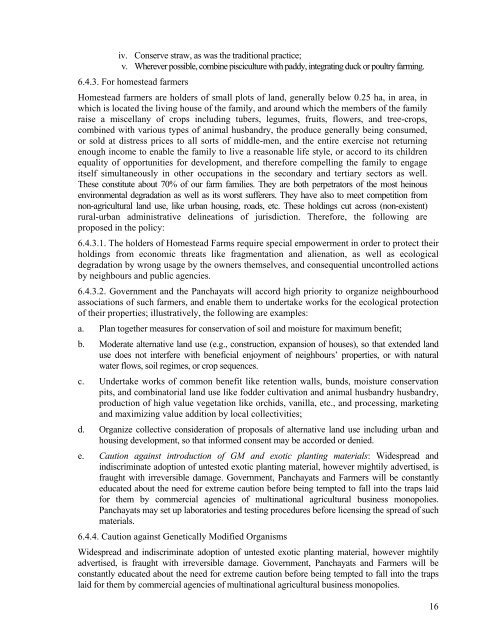DRAFT ENVIRONMENT POLICY - India Water Portal
DRAFT ENVIRONMENT POLICY - India Water Portal
DRAFT ENVIRONMENT POLICY - India Water Portal
Create successful ePaper yourself
Turn your PDF publications into a flip-book with our unique Google optimized e-Paper software.
iv. Conserve straw, as was the traditional practice;v. Wherever possible, combine pisciculture with paddy, integrating duck or poultry farming.6.4.3. For homestead farmersHomestead farmers are holders of small plots of land, generally below 0.25 ha, in area, inwhich is located the living house of the family, and around which the members of the familyraise a miscellany of crops including tubers, legumes, fruits, flowers, and tree-crops,combined with various types of animal husbandry, the produce generally being consumed,or sold at distress prices to all sorts of middle-men, and the entire exercise not returningenough income to enable the family to live a reasonable life style, or accord to its childrenequality of opportunities for development, and therefore compelling the family to engageitself simultaneously in other occupations in the secondary and tertiary sectors as well.These constitute about 70% of our farm families. They are both perpetrators of the most heinousenvironmental degradation as well as its worst sufferers. They have also to meet competition fromnon-agricultural land use, like urban housing, roads, etc. These holdings cut across (non-existent)rural-urban administrative delineations of jurisdiction. Therefore, the following areproposed in the policy:6.4.3.1. The holders of Homestead Farms require special empowerment in order to protect theirholdings from economic threats like fragmentation and alienation, as well as ecologicaldegradation by wrong usage by the owners themselves, and consequential uncontrolled actionsby neighbours and public agencies.6.4.3.2. Government and the Panchayats will accord high priority to organize neighbourhoodassociations of such farmers, and enable them to undertake works for the ecological protectionof their properties; illustratively, the following are examples:a. Plan together measures for conservation of soil and moisture for maximum benefit;b. Moderate alternative land use (e.g., construction, expansion of houses), so that extended landuse does not interfere with beneficial enjoyment of neighbours’ properties, or with naturalwater flows, soil regimes, or crop sequences.c. Undertake works of common benefit like retention walls, bunds, moisture conservationpits, and combinatorial land use like fodder cultivation and animal husbandry husbandry,production of high value vegetation like orchids, vanilla, etc., and processing, marketingand maximizing value addition by local collectivities;d. Organize collective consideration of proposals of alternative land use including urban andhousing development, so that informed consent may be accorded or denied.e. Caution against introduction of GM and exotic planting materials: Widespread andindiscriminate adoption of untested exotic planting material, however mightily advertised, isfraught with irreversible damage. Government, Panchayats and Farmers will be constantlyeducated about the need for extreme caution before being tempted to fall into the traps laidfor them by commercial agencies of multinational agricultural business monopolies.Panchayats may set up laboratories and testing procedures before licensing the spread of suchmaterials.6.4.4. Caution against Genetically Modified OrganismsWidespread and indiscriminate adoption of untested exotic planting material, however mightilyadvertised, is fraught with irreversible damage. Government, Panchayats and Farmers will beconstantly educated about the need for extreme caution before being tempted to fall into the trapslaid for them by commercial agencies of multinational agricultural business monopolies.16

















